Want to know how to use watering globes so they actually work? Yeah, me too.
Watering globes, watering spikes, aqua globes, or whatever you want to call them sound like the perfect answer to the busy plant lover’s life.
These plant care devices have grown in popularity lately, but what exactly are watering globes? They are pretty glass, plastic or sometimes metal orbs that promise to keep your indoor potted plants watered for up to two weeks, providing controlled watering with no effort from you.
Some people have even made DIY versions using empty wine bottles or plastic water bottles! I’ll go through that later in this post.
These self watering systems sound ideal for people who often forget to water their plants, or for people who often go on vacations or business trips. However, do they really work as advertised?

How do watering globes work?
Watering globes are used for plant watering. They work by filling the orb about 3/4 way with water. You insert the globe into the soil, and the water slowly seeps from the long thin neck into the plant’s soil, providing constant soil moisture over time.
As the water trickles out, a weak vacuum is formed within the globe, stopping too much water from escaping at once. As the soil moisture depletes, air can enter the globe once again and cause more water to be released. This keeps a steady supply of water entering the soil over time.
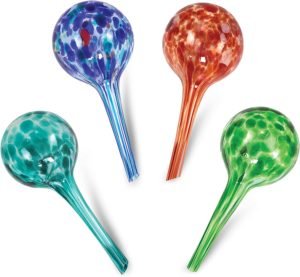
How long do watering globes last?
Watering globes are said to last between 1-2 weeks, depending on the size of the globe and the size of your potted plants. Watering globes come in a variety of sizes, small for small plants, and large for large plants. Some even come in fun shapes, like the mushroom style.
However, you may find small globes emptying quicker than larger ones. For my spider plant, the small globe I used emptied overnight. Even after a good watering and packing the soil down as suggested by customer support, the globe was always empty the next day.
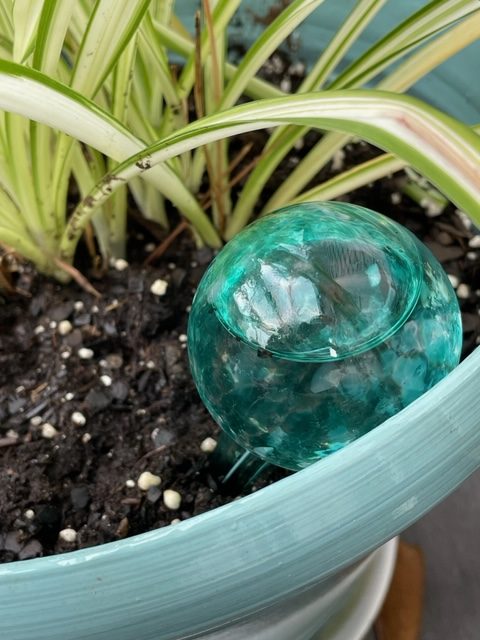
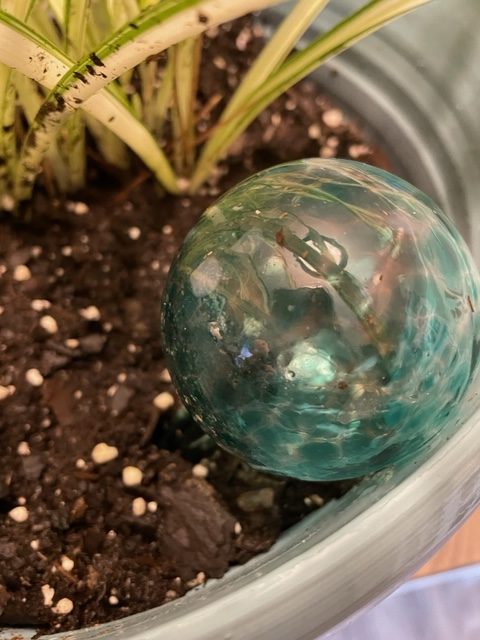
How to use watering globes
Below is how to set up and use a watering globe. Most globes are made of blown glass, so be sure to handle carefully because they are fragile and can break. Watering globes are not recommended for outdoor plants due to their fragility.
PRO TIP: These make great gifts for plant lovers 😉
Step 1: prepare your globe
Out of the box, a new aqua globe will need slight preparation. I rinsed the globe out with water to remove any dust or particles that may have been inside. Turn the globe stem side up, and rinse with water from the kitchen or other sink in your home. Fill it with water about half-way, swirl the water around, and pour it out.
Step 2: fill your globe
Next, you will fill your globe with water that will be going to your plant. For this step, I used filtered water. I used a water pitcher with a spout to make pouring the water easier, as the opening to the globe is narrow. Fill the globe about 3/4 of the way full (half-way up the stem, but not completely full).
Step 3: insert your globe into the soil
Be sure to give your plant a good watering before you insert the globe. This will prevent the water from emptying out too quickly.
After you have filled your globe with water, you will now carefully insert it into your soil. However, you can’t just stick it in the soil and push down. The pressure can cause the bulb to crack or break, and the last thing you want in your plant’s soil is glass shards.
- To properly insert the globe, you can use a thin stick (such as a pencil or thin dowel rod) to make a small hole in your soil.
- Then, try to quickly flip the globe over and place it in the hole.
- If the globe doesn’t go into the soil, remove it and make the hole a bit bigger.
Keep repeating this process until the globe slides down into the soil snugly, to where it will hold itself up.
I also packed the soil a bit tighter around the globe after inserting to prevent too much water from escaping. A little water will spill out at first, but the vacuum should activate and slow this down. Now your globe should provide a slow and steady supply of water whenever the soil dries out.
Step 4: monitor your plant
After the watering globe has been established, you will still need to monitor the globe and plant for any unwanted changes. The globe will eventually empty, and must be refilled to continue to do its job.
Also, you will need to provide periodic cleaning, especially if you see algae or debris floating inside the globe. For instance, the neck of the globe may be clogged with soil. If this happens, a cotton bud or narrow pipe cleaner can be used to loosen and rinse it out.
PRO TIP: If your globe gets a cloudy appearance, then it is time to clean. Wash it with dish detergent, a mixture of baking soda and warm water, or baking soda and lemon juice and let dry. Once the globe dries, it is ready to use again.
My honest review
The watering globe is relatively easy to use. The glass is fragile, so it needs to be handled carefully, as with any glass object. The opening is rather small, so a cup with a spout for pouring is the easiest way to pour the water in without too much spillage. A steady hand is beneficial too, which I did not have, so I poured the water in over the sink.
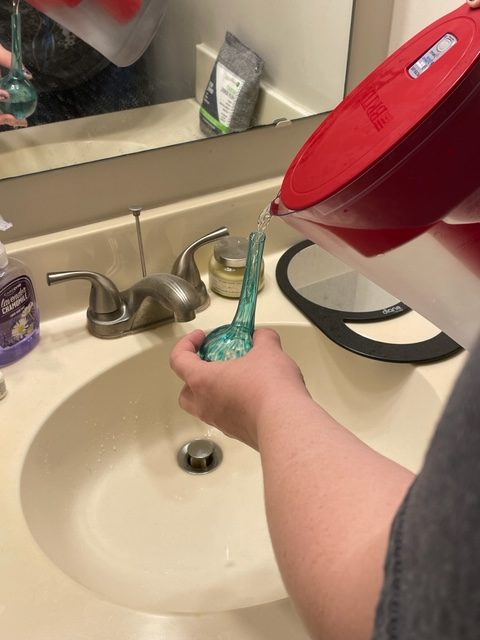
I prepared the globe by first rinsing it out. The globe was new from the box, but I washed off any dust or particles that may have been on or inside of it.
Then, I poured in filtered water from my Brita pitcher until it was about ¾ full. I used filtered water as tap water can contain minerals and metals that can damage living plants. About ½ cup of water filled the globe to the amount necessary.
Before inserting the globe, I gave my plant a good watering. Then, I used a pencil to make a hole in the soil, at a slight angle before inserting the globe. I gently placed the globe down into the soil and waited.
My globes did not last as long as advertised. By the next day, the water had drained out completely. Even following the instructions that came with the product did not help. It may be due to using the small sized globes, but they did not work well for me.
NOTE: Myself and readers have noticed that putting the watering globe in straight up and down means the water does not escape too quickly. Putting it in at an angle allows more air to enter through the opening, which displaces water more quickly… causing it to drain within a few hours.
I also reached out to customer support, which was wonderful and quick to respond, and recommended I pack the soil tighter to help the vacuum activate. However, this also did not help the globe hold water, and it was drained again by the next morning.
From my experience, I would not recommend water globes to a friend or any avid gardener. The globes look aesthetically pleasing and are a beautiful addition to my potted plant, but they just don’t work as well as they are described. They drained too quickly and waterlogged my spider plant.
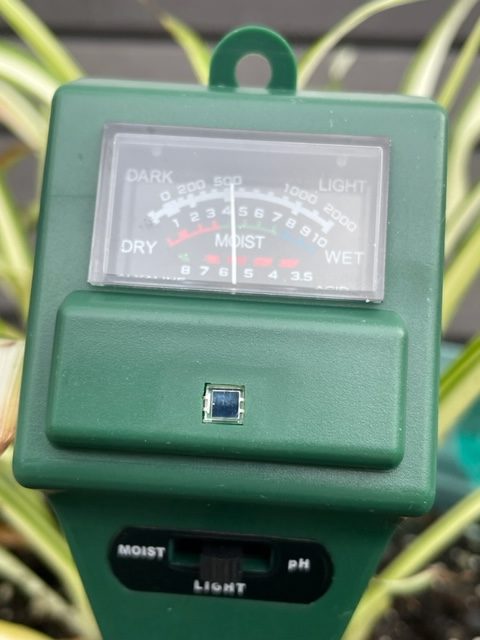
I used a moisture meter to track the moisture, and it raised each time the globe emptied, yet the water continued to drain. I don’t think my plant responded well to using the globes at all, and I discontinued use before my plant suffered from the increased watering. These globes could lead to dangerous problems associated with overwatering, such as damaging the plant’s roots (root rot).
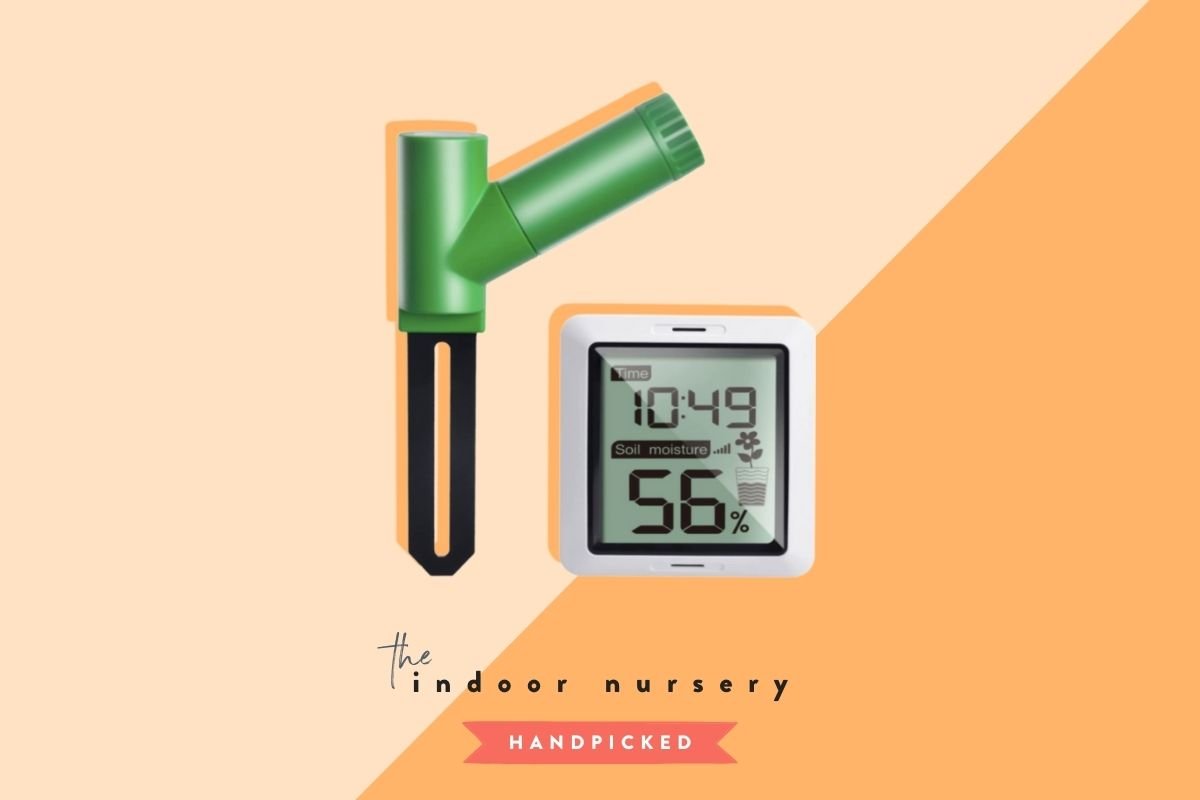
From what I experienced, this product would not work for someone on vacation, as it is advertised. My water globe had completely drained by the next morning. If someone was gone for a few days, it may not be a problem, but for a week-long trip or more, it would not be ideal to keep the plant watered consistently.
After speaking to customer support via email, they suggested I press down and pack the soil tighter in order to have the globe activate the vacuum and make the water not drain out so fast. Doing this did not improve the situation, and the globe still drained too fast. I had done extensive research and read several reviews on Amazon that praise these globes, however, they just didn’t work for me.

It may be due to the type of soil I used, as watering globes work differently in different soil types. Many plants that like wet soil will benefit from these globes. If you are interested in trying watering globes, see for yourself if they work for you. If not, it may be better to stick to a regular watering schedule.
What to do instead – DIY watering globe
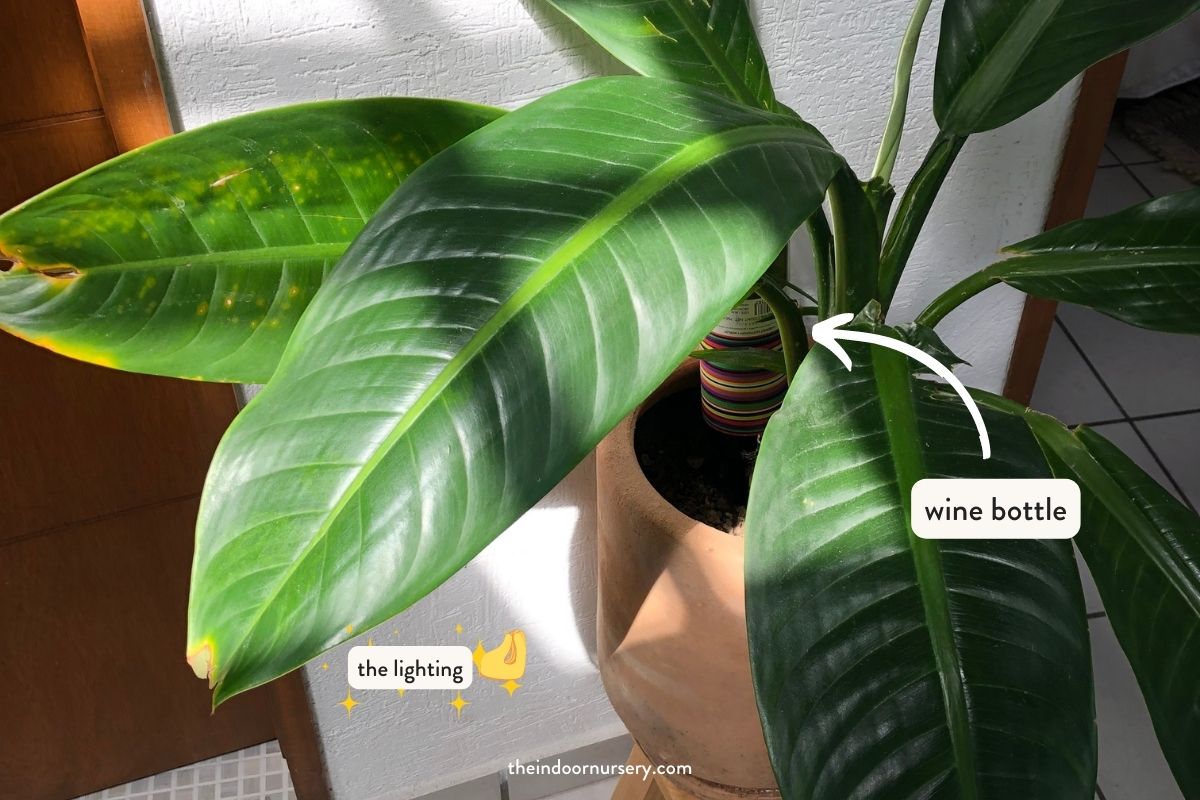
It seems like a watering bulb could work for a lot of different people. The reviews online for this nifty little watering spike look promising. It could also be the case that the planter and soil that my spider plant was in was not in a good condition to work with these particular self watering globes.
I also don’t think that plant watering globes are a good fit for certain types of plants, like succulents, that require rocky or soilless potting mix as the water flow may be too rapid for this type of watering system.
Other types of houseplants, however, such as figs, pothos, or other thirsty plants could work well with aqua globes.
That being said, I’d recommend giving a DIY watering globe a try: use a wine bottle, beer bottle, or other empty glass bottle you have in the recycling bin instead. Paired with these ceramic watering stakes makes it easy to use, clean, and slowly water plants over time.
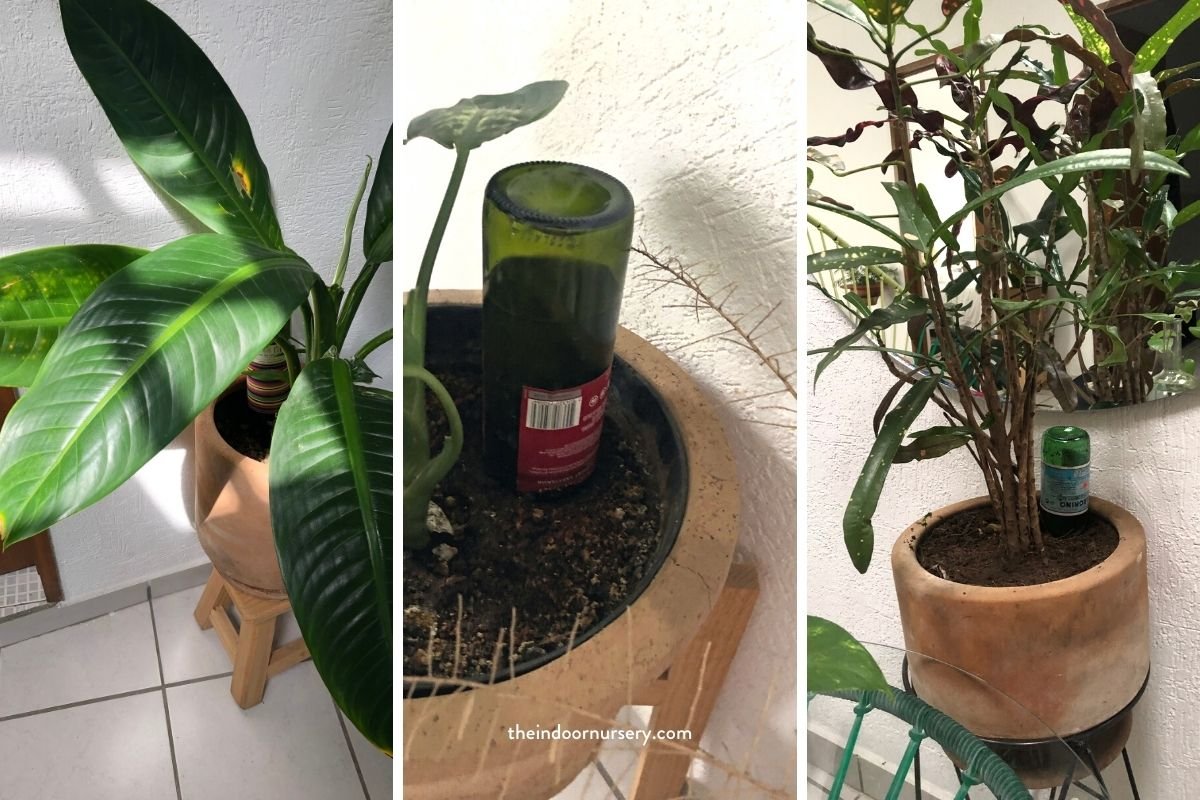
This will give you a larger reservoir for holding water and a wider spout for cleaning and refilling. The glass will also be stronger than these glass-blown plant watering globes, so you can feel a little more confident pushing them into the soil.
More about watering plants
- How Often To Water Dracaena (Including Snake Plants)
- How to Use Leca for Plants: Step-by-Step Guide with Pictures
- How To Save An Overwatered Snake Plant
- How Often To Water Pothos Plants (And When To Cut Back)
- How Often To Water Monstera Plants
- 11 Plants That Don’t Need Drainage And How To Care For Them
- Save Your Overwatered Monstera In 4 Steps (And How Not To Do It Again)

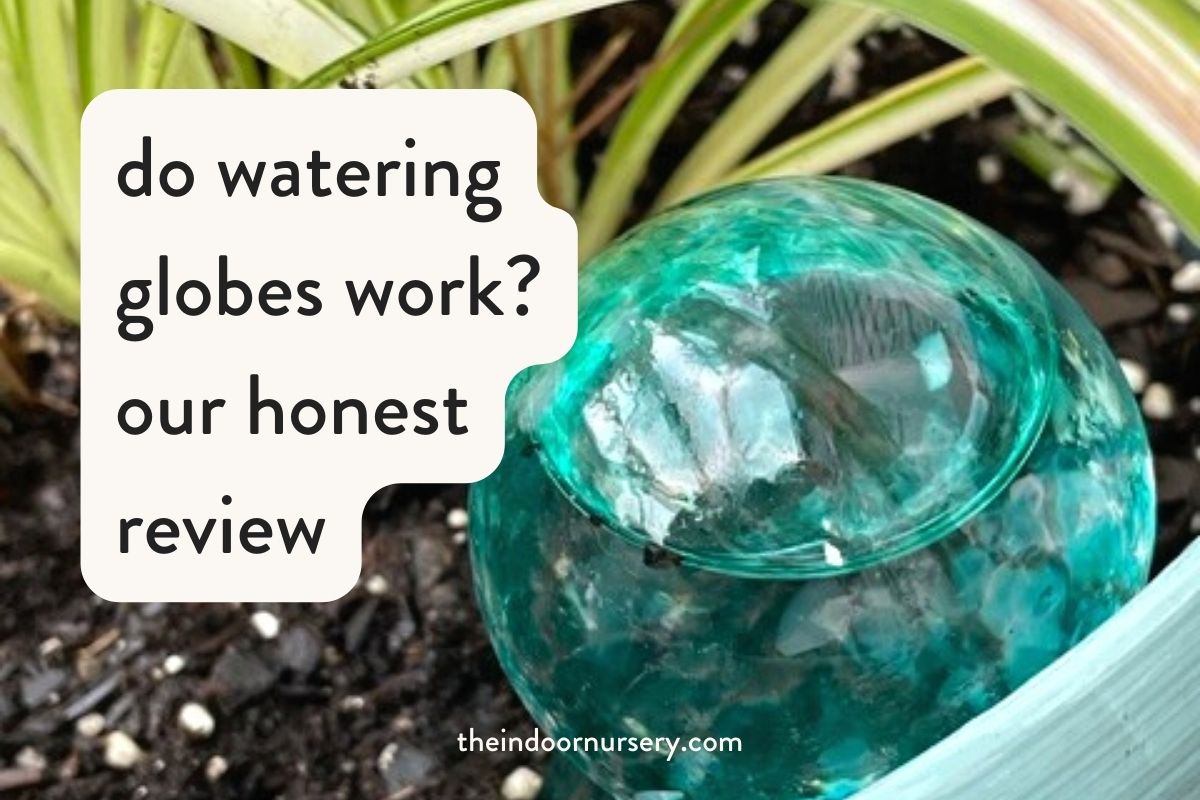
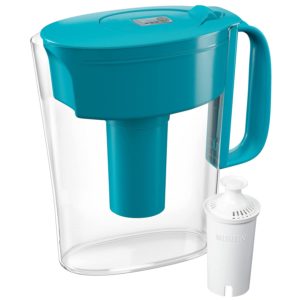

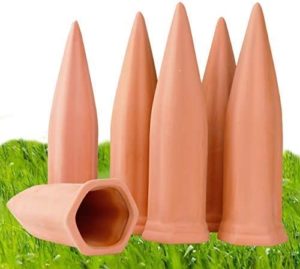
I will be traveling for two weeks and worried about my Prayer Plant that I just brought back to life after almost 15 months of near death lol so thought I’d give these globes a try. VERY disappointed as I had the same thing happen….filled globe inserted in soil and within a few hours the soil was overly soaked and my pot was floating in the saucer!! The globe had emptied completely.
Hey Joyce.
Since the publishing of this post, we persisted with the water globes. But, like you, had little success.
Although, something we have discovered recently is ceramic and Blumat watering stakes.
The ceramic stakes are used with a wine bottle. Kind of like Allison described above, but instead of sticking the wine bottle straight into the soil, you insert the wine bottle nose-down into the stake. The ceramic causes the water to flow out slowly over time, rather than seemingly instantly, like the water globes do.
The Blumat watering stakes are similar. But instead of inserting a wine bottle into them, they are fitted with a plastic tube. The plastic tube runs from the top of the stake and is placed into a container of water. The water then syphons through the pipe and into the potting soil the stake has been placed in.
Both of these products we’ve found much more helpful than water globes.
I hope these solutions are helpful to you!
How to get the air locks out of the globes or am I filling them too full?
Hi, Diane! Have you resolved this issue yet? If you turn the watering globe upside down, so that the pointy end is facing upward, then the air should natural move out. When you put them into the soil, the air from the soil will replace the water as the water comes out. This is a natural process and will continue until the globe is empty. Is this what you mean?
I just bought a large bulb (about 3″ across by laying it on a ruler) and I have a large peace lily which is probably root bound. My first attempt seemed to be nonproductive. I didn’t have any clear instructions. It is easy to over water it. I am using water which I have let sit out for 24 hours, having read this is good when you use tap water. Am in assisted living so don’t have access to a lot of things. I do have a PUR water pitcher. Any suggestions?
Hi, Sharon! It sounds like you’re doing all of the right things 🙂 I’ve had a peace lily before and they are quite hardy, though they really like regular watering. If your peace lily is root bound, then I suggest repotting it. I really like Fox Farm soil, it has all of the nutrients and microbes that you need. This will also make it easier to get the watering globe into the soil gently. I haven’t found the watering globes to be especially effective. I’m going to add an alternative product at the bottom of this post, ceramic watering stakes. It’s really easy to use, clean, and to fill up your own bottles of water comfortably.
hi, i have used these water globes for a while now and think they are very good.
However, i find that you should water your plant well first and let it drain. Ensure the compost is not loose or the water will drain out. Then insert the water globe, it should last – I have only used the long stemmed globes and also only use water from my garden water butt.
Hope these tips also last 🙂
Hey, Jeni! That’s a great tip to water the plant first and let it drain. This should definitely help slow the water flow when first putting the watering globes in. Thanks for sharing 🙂
I put a small piece of mesh over the spout (taped in place) to prevent the soil clogging the opening. Works great, but the globes empty too quickly I’m going to try the ceramic nozzles next. Wish me luck.
Hey, Sue, That’s a great idea about the mesh!! I think ceramic nozzles are a better idea as well. I was unimpressed by the watering globes.
I just got a beautiful blown glass bulb with a glass frog on top, absolutely beautiful, for Mother’s Day. For a first trial I put it into a Cyperus Alternifolius (Papyrus) plant that loves all the water it can get. It was well watered already, but as you said about yours, it emptied overnight, which is how I ended up here wondering what I did wrong! The good thing is this plant will love it, but not sure if I want to fill it up everyday or not! It sure is pretty though.😃
Hi, JoLyn! Thanks for reading 🙂 Sorry to hear that your watering globe is draining so much. I find that they really do that a lot of the time. I’ve found better luck using wine bottles in the same fashion: filling with filtered water and then putting upside down in the soil. They’re also easier to clean and refill. Otherwise, you’re right that watering globes sure are pretty!!
I have more success if I push bulb straight down. Inserting at an angle lets more air in a drains out all the water
Hi, Nancy! Thanks for reading 🙂 excellent tip, we didn’t try that but I’m glad you mentioned it. Hopefully this helps other readers!
I’m glad someone finally noted this. I had no luck with watering bulbs because I kept inserting them at an angle. But straight up and down, the water does take a week or so to drain. I have the larger bulbs.
My bulb isn’t emptying at all. It might be because I overfilled it but I made sure it’s tilted and not clogged.
I’m trying to water my amaryllis that’s gonna be going in a dark cold place after summer.
I can only find 6.5″ to over 7″ terracotta watering spikes. Want to use them in conjunction with the globes. Have done that with larger house plants and works great. But have a lot of plants in smaller pots where the terracotta spikes are just too big. Are there smaller ones? I haven’t been able to find any.
Thanks.
Hey, Marcia! Thanks for reading 🙂 gosh, that’s a great idea to double up on your watering globe and spike. I also cannot find anything smaller than 6.5″ (or at least clearly labeled as such). I wonder if such a small potted plant would need so much water that you would need both the spike and the globe? What has been your experience, have you found something that works yet?